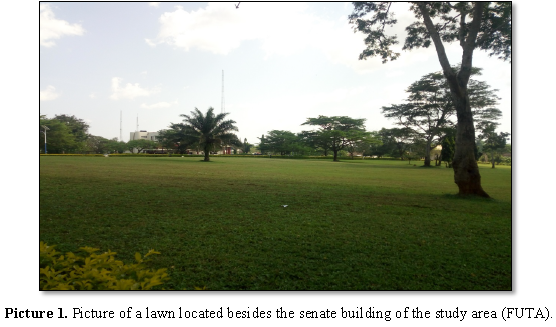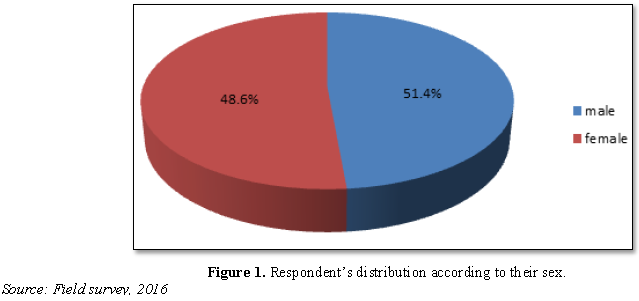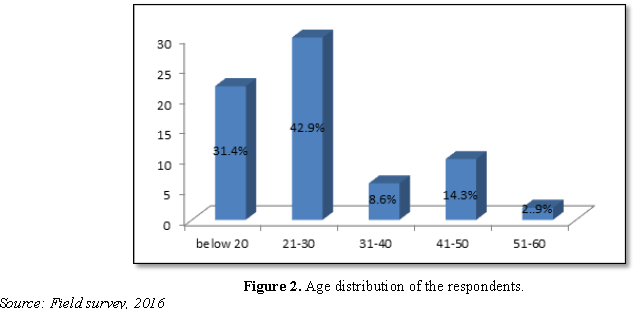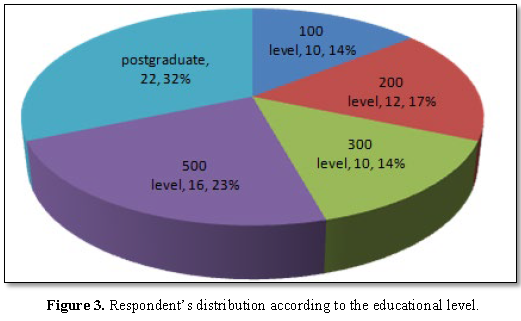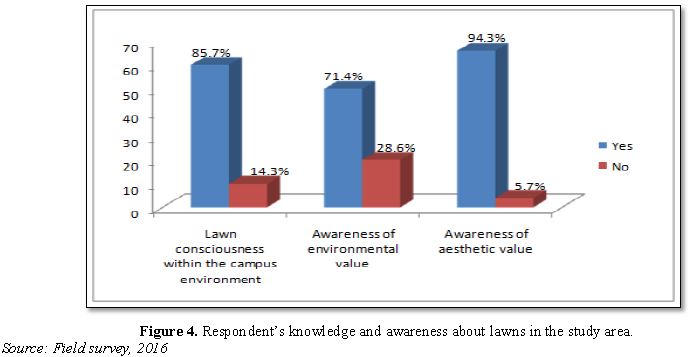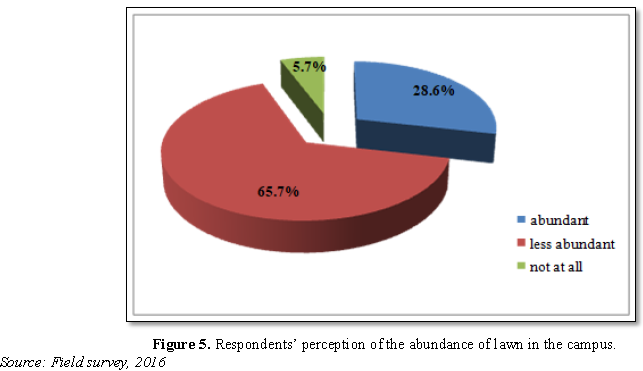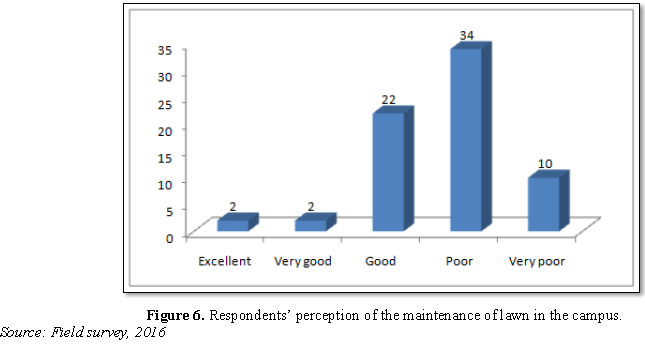618
Views & Citations10
Likes & Shares
The image of the landscape mirrors the state of the
environment of many organizations and campuses in Nigeria. In recent time green
lawns has been considered as of the landscape design to optimally utilize and
beautify open spaces in campus area. This study was conducted among students of
Federal University of Technology Akure, to assess their knowledge and
perception about the aesthetic and environmental effects of lawns within the
campus. Simple random sampling technique was used to select seventy seven (70)
respondents for the study both undergraduate and postgraduate students. Data
were collected through the use of a well-structured pre-tested questionnaire
and analyzed using descriptive statistics. Findings from the study revealed
that majority (85.7%) of the respondents had knowledge and were conscious of
the aesthetic value of lawns within the campus. The study further revealed that
the respondents have positive perception towards the aesthetic and
environmental effects that lawns have in their environment. Also, majority
(65.7%) of the respondents perceived the less abundance of lawns within the
campus and also poor maintenance of the lawns available within the campus
environment.
Keywords: Urban
green area, Environmental quality, Recreation, Aesthetics, Turf
INTRODUCTION
The term lawn
simply refers to a managed grass space, whose existence could be dated back to
no earlier than the 16th century [1]. A lawn is an area of soil covered land
planted with grasses and other durable plants such as clover which are
maintained at a short height with a lawn mower and used for aesthetic and
recreational purposes (“Lawn”, n.d.). According to [2] lawn is one of the
landscape elements which are used to develop and refine spaces between, around
or within buildings and vehicular routes when they occur either intentionally
or accidentally. Lawn is very common in public organizations and private places
today serving the purpose of covering piece of land or space that would rather
be lying fallow and growing bushy.
Among the 44 identified types of urban green
areas, the lawn is one of the most common elements, for example in large urban
parks, botanical and zoological gardens, historic parks/gardens, institutional
green spaces, green playground/school grounds, street green or green verges and
house gardens [3]. Hence, since the 20th century, lawns has been
used as a massive prefabricated element in all green areas both in the public
and private, and also seen as symbol of globalization and market economy today
[4].
In Nigeria today, many institutions have
consciously or unconsciously added some physiographic and environmental
appealing attributes to the spaces found in their domain which has actually
defined them and made them distinctive in such that it even serves as source of
attraction to prospective students and means of aesthetic gratification and
tool for environmental conservation. The federal university of technology Akure
is no exception of this, as they possess a monumental design and landscape
which is spacious, dignified and distinctive.
The federal university of technology Akure
has various lawns within the campus environments with the predominance of
grasses like Axonopus compressors
commonly known as Bahama grass, Cynodon
dactylon commonly known as Carpet grass and the Chrysopogon aciculatus commonly known as Port Harcourt grass or
English love grass. Examples of
locations where some
of
Ignatieva et al. [5] opined that at a time of
climate change and the search for a sustainable urban environment, there is an
urgent need to have interdisciplinary empirical quantitative and qualitative
studies on lawns i.e. the values of different lawns and conclusions drawn about
their negative and/or positive environmental impact. Therefore, this paper,
therefore, sought to assess the knowledge and perception of students of the
Federal University of Technology Akure (FUTA) on the environmental and
aesthetic effects of lawn within the campus environment. The objectives of the
study were to:
1.
Ascertain some selected socio-economic
characteristics of respondents;
2.
Assess the knowledge of students about
the presence of lawns in the campus environment;
3.
Determine the perception of students
about the environmental and aesthetic effects of lawn in the study area;
4.
Assess the perception of students
towards the maintenance of lawns in the study area.
MATERIALS AND
METHODS
The area of the study is Federal University
of Technology Akure (FUTA) located in the capital city of Ondo State in
Nigeria. It is located in the Southwestern part of Nigeria which lies between
latitude 50 45” and 80 15” North and longitude 40 30” and 60 East with the
coordinate of, 7°15′0″ N, 5°11′42″ E. The study area has several lawns located
in strategic open spaces within it, which has made the university environment
beautiful, charming and cool to visitors. Simple random sampling technique was
used to select seventy seven (70) respondents for the study. The sampled
population drawn for the study comprised of students (both undergraduate and
the postgraduate) of Federal University of Technology Akure, Ondo state,
Nigeria.
A well-structured questionnaire was used to
obtain data for the study. The questionnaire was divided into two main parts.
Part 1 was structured to elicit data some demographic characteristics of the
respondents and 2nd part was designed to get information aimed at
providing answers to the research questions considered in the study which
centers on the perception of the respondents on the aesthetic and environmental
effects of lawns within the campus environment.
To assess the knowledge of respondents about
the presence of lawns within the campus environment, respondents were asked to
respond to questions which affirmed their knowledge about lawns, a dichotomous
response Yes=1, No=0 was used to assess the awareness of each respondents and
on the other hand a 4-pole rating scale (Very abundant=3, Abundant=2, Less
abundant=1 and not at all present=0) and 5-pole rating scale (Excellent=5, Very
Good=4, Good=3, Poor=2 and Very Poor=1) was used to assess their knowledge of
abundance of lawns and quality of lawns within the campus, respectively.
Descriptive statistics was used to analyze this.
To assess the perception of the respondents
about the aesthetic and environmental effects of lawns within the study area,
list of various perceptional statements were framed through interview with
experts in horticulture, opinions from people and through the review of
relevant literatures. Likert [6] designed Likert scale of measuring
psychological concepts like attitudes, perception, etc. Therefore, a 5 point
likert-type scale with Strongly Agree=5, Agree=4, Neutral=3, Disagree=2 and
Strongly Disagree=1 was used to assess their perception. The mean score of each
perceptional statement were obtained and any statement with mean score above
3.00 was judged to be statement agreed with and those less than 3.00 mean score
was said to be disagreed with [7].
To assess the perception of students towards
the maintenance of lawns in the study area, respondents were asked to rate the
management maintenance practices of the lawn in the university on a 5-pole
rating scale, Excellent=5, Very Good=4, Good=3, Poor=2 and Very Poor=1. And
descriptive statistics was used to analyze this [8,9].
RESULTS AND
DISCUSSION
Distribution of
respondent’s according some selected socio-economic characteristics (N=70)
Knowledge of
students about lawns in the campus environment
Figure 4 indicated that majority (85.7%)
of the respondents had the knowledge and are conscious of the presence of lawns
in several locations around the campus. It also revealed that 71.4% of the
respondents had the knowledge and awareness of the environmental values and
effect that lawns give to the locations and environments where they are found.
Again, Figure 4 showed that 94.3% of
the students that responded to the question were knowledgeable about the
aesthetic value of lawns that are found in the area and this was further
affirmed in objective 3 of this study where majority of the respondents had
positive and high score in the perceptional statements of aesthetic value of
lawns in the campus.
Distribution of
respondents according to their responses to the perceptional statements on
environmental effects of lawn in the study area
Regarding the answers to statements given to
respondents (Table 1) about their
perception of the environmental effects of lawns in the campus environment,
people had quite a range of opinions. However, the result in Table 1 showed that “lawns prevent soil
erosion”, “it reduces water runoff” and “Lawn improves dust control” had higher
mean score (x̅=4.80, x̅=4.69 and x̅=4.57), respectively. This opinion can
probably be explained by the fact that respondents had not experienced or seen
soil erosion or water runoff in areas covered with lawns and grasses within the
campus or rather had had experienced dust in the area which they presumed are
been controlled by the presence of the lawns.
Distribution of
respondents according to their responses to the perceptional statements on
aesthetic effects of lawn in the study area
Results in Table 2 revealed that the respondents agreed to all the statements with high mean score of above 4.00, this shows that the respondents have high and good perception about the aesthetic values of lawns within their campus. The quite high ranking mean score and a positive response from FUTA students towards the aesthetic value of lawns in there campus environment could be, possibly because modern people are hungry for nature and green environment. Another explanation for this positive response is because most of the students have seen in photographs the settings and landscape of universities in the western world which they consider as models for their own institution. Hence, they appreciate and are aware of the aesthetic values of grasses and lawns in their campus.
Result in Figure 5 showed that majority (65.7%) of the respondents perceived that the lawns in the study area were less abundant. This could be implied from the fact that they still see many open spaces within the school environment been left to fallow, which would have rather been covered with grasses and lawns that could add beauty to the landscape of the school environment. Hence, there is the need for the school management and the horticultural unit to work on more establishments of more lawns in free open spaces within faculties and other appropriate places.According to Figure 6, 48.57% of the students interviewed rated the maintenance level of the lawns within the campus to be poor. Only 31.43% was of the view that the maintenance level is on the average (good). Therefore, it could be concluded that lawns within the campus environment is not properly maintained as expected by the students which could be due to the poor allocation of funds for its maintenance by the university management following its underestimated role and importance within the school environment.
CONCLUSION
The study assessed the perception of Aesthetic effects and environmental effects of Lawns in the Federal University of Technology Akure Campus, Ondo State, Nigeria. The population for the study comprised of all students of the University from which some were sampled randomly to be the respondents for the study. This study revealed that the students of the campus have knowledge about the environmental and aesthetic effects of lawns within their campus and they are positively disposed to the effects these lawns has on the environment in terms of beauty gratification and environmental conservation. Respondents have the perception that lawns are less abundant and poorly maintained within the campus environment.Since the respondents had negative perception about the abundance and maintenance of the lawns in the campus environment, the school management and the horticultural units and landscape improvement related departments should synergize together to ensure the open areas are improved upon by planting lawns and ensuring its utmost maintenance since the students has positive perception of its values.
1. Robbins P (2007) Lawn people: How
grasses, weeds and chemicals make us who we are? Philadephia, Temple University
press, p: 186.
2. Adekunle OJ, Basorun JO (2016) The
evolving roles of landscaping in campus space management: Ekiti State
University, Ado-Ekiti, Nigeria in focus. J Environ Protect 7: 1380-1388.
3. Ignatieva M, Eriksson F, Eriksson
T, Berg P, Marcus H (2017) The lawn as a social and cultural phenomenon in
Sweden. Urban Forestry and Urban Greening 21: 213-223.
4. Ignatieva M (2010) Design and future
of urban biodiversity. In: Müller N, Werner P, Kelcey J (Eds.), Urban
Biodiversity and Design. Blackwell, pp: 118-144.
5. Ignatieva M, Ahrné K, Wissman J,
Eriksson T, Tidåker P, et al. (2015) Lawn as a cultural and ecological
phenomenon: A conceptual framework for transdisciplinary research. Urban
Forestry and Urban Greening 14: 383-387
6. Likert R (1932) A technique for
the measurement of attitudes. Arch Psychol 22: 1-55.
7. Essaghah A (1997) Urban planning
concepts, standards and symbols. Amfitop Books Nig. Ltd., Lagos.
8. https://en.m.wikipedia.org/wiki/Lawn
9. Wright RT (2008) Environmental
science: Toward a sustainable future. PHI Learning, New Delhi.
QUICK LINKS
- SUBMIT MANUSCRIPT
- RECOMMEND THE JOURNAL
-
SUBSCRIBE FOR ALERTS
RELATED JOURNALS
- Journal of Genetics and Cell Biology (ISSN:2639-3360)
- Journal of Womens Health and Safety Research (ISSN:2577-1388)
- Journal of Veterinary and Marine Sciences (ISSN: 2689-7830)
- Proteomics and Bioinformatics (ISSN:2641-7561)
- Advances in Nanomedicine and Nanotechnology Research (ISSN: 2688-5476)
- Journal of Astronomy and Space Research
- Journal of Genomic Medicine and Pharmacogenomics (ISSN:2474-4670)

